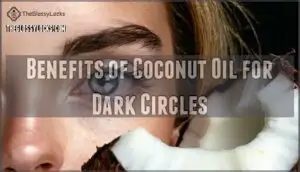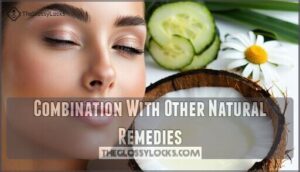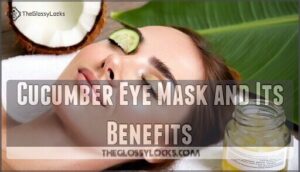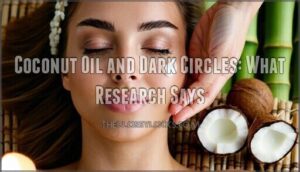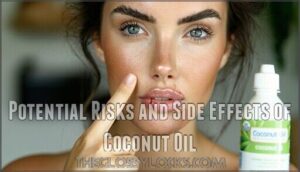This site is supported by our readers. We may earn a commission, at no cost to you, if you purchase through links.
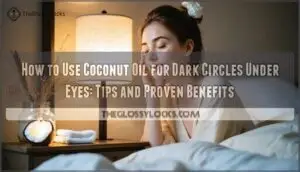
Let it soak in overnight—think of it as a soft blanket for tired skin.
In the morning, wash your face with a gentle cleanser.
Coconut oil’s fatty acids help lock in moisture, though results might take time and vary for everyone.
Always check for allergies first; your skin’s no place for surprises.
Curious about other natural tricks or what science says about coconut oil? There’s more to uncover ahead.
Table Of Contents
- Key Takeaways
- Causes of Dark Circles Under Eyes
- Benefits of Coconut Oil for Dark Circles
- Choosing The Right Coconut Oil
- How to Apply Coconut Oil for Dark Circles
- Additional Remedies for Dark Circles
- Coconut Oil and Dark Circles: What Research Says
- Potential Risks and Side Effects of Coconut Oil
- Tips for Effective Use and Long-Term Results
- Frequently Asked Questions (FAQs)
- How to use coconut oil to treat dark circles?
- How to get rid of dark circles under eyes?
- Is coconut oil good for under eye circles?
- How to reduce dark circles & puffiness under eyes?
- Does coconut oil help under-eye circles & dehydration?
- How to get rid of dark eyes naturally?
- Does coconut oil remove dark circles under eyes?
- How to quickly remove dark circles under eyes?
- Is it safe to put coconut oil around your eyes?
- Which oil is best for removing dark circles?
- Conclusion
Key Takeaways
- Always patch test coconut oil before using it under your eyes to avoid irritation or allergic reactions.
- Apply a small amount of cold-pressed, virgin coconut oil nightly, gently massaging it into clean skin for best results.
- Don’t expect overnight changes—consistent use and healthy habits like good sleep and hydration make the biggest difference.
- If dark circles persist or worsen, check with a doctor to rule out underlying health issues.
Causes of Dark Circles Under Eyes
You might notice dark circles under your eyes for many reasons, including aging, dehydration, lack of sleep, allergies, or even certain health conditions.
Understanding what causes them can help you find the best way to manage or reduce their appearance.
Aging and Skin Thinning
As you age, your skin gets thinner and loses its bounce, thanks to collagen loss and elastin breakdown.
This makes dark circles more noticeable, especially if you have a genetic predisposition or sun damage.
Watch out for:
- Dermal atrophy making veins visible
- Sun damage speeding up aging skin
- Coconut oil helping as an undereye treatment for skin thinning
Dehydration and Lack of Sleep
As skin thins with time, dehydration and lack of sleep can make dark circles even more noticeable.
Sleep deprivation lowers your skin elasticity and slows down cellular repair, leaving the under-eye area looking tired and dull. Low hydration levels mean your body can’t flush out toxins or keep your skin plump.
If you want to improve your undereye treatment routine and reduce dark circles, try these steps:
- Drink at least 8 cups of water daily
- Create a calming bedtime routine
- Limit screen time before bed to help with sleep deprivation and maintain proper hydration levels.
Allergies and Medications
After a restless night, you might notice dark circles, but allergies and medications can also play a big part.
Allergy triggers and certain medication side-effects, like antihistamine effects or drug interactions, can lead to under-eye discoloration.
If you’re prone to skin allergies, always patch test new products, as even over-the-counter remedies can cause a skin reaction or worsen underlying conditions.
Liver Disease and Other Health Issues
If allergies or medications aren’t the cause, health conditions like liver disease, kidney function problems, thyroid disorders, or anemia effects could be behind those stubborn dark circles.
Sometimes, autoimmune conditions play a role. Persistent under-eye discoloration isn’t just about looks—it can signal underlying health issues.
If dark circles stick around, schedule a doctor consultation to check for liver disease or other concerns.
Dark circles can also be caused by vitamin B12 deficiency, which increases skin pigmentation.
Benefits of Coconut Oil for Dark Circles
When you use coconut oil for dark circles, you give your skin a boost of fatty acids, antioxidants, and moisture.
Coconut oil delivers hydration, antioxidants, and fatty acids—giving your under-eye skin the support it needs to look brighter and healthier.
These ingredients may help strengthen the skin barrier, improve texture, and reduce the appearance of dark circles over time, which can be achieved by using coconut oil with its moisture.
Rich in Beneficial Fatty Acids
If you’re looking for natural remedies to tackle dark circles, coconut oil packs a punch thanks to its fatty acids.
These help with Fatty Acid Benefits, Anti-inflammatory Action, Circulation Improvement, and Cell Turnover.
Here’s how the main ones work:
- Lauric acid: reduces puffiness.
- Capric acid: boosts circulation.
- Caprylic acid: supports skin healing and cell turnover.
These help your undereye skin treatment routine, providing Anti-inflammatory Action.
Natural Moisturizer and Skin Strengthening
Think of coconut oil as your under-eye skin’s shield. It’s a natural moisturizer that locks in hydration benefits, keeping the area soft and less prone to dryness.
The fatty acids and nutrients help strengthen your skin barrier, offering gentle support for collagen and overall skin strengthening. With regular use, you’ll notice smoother, more resilient skin—one step closer to brighter eyes.
It can also help to fade hyperpigmentation with consistent and regular use, which is a significant benefit for those looking to improve their skin appearance, and overall, it provides a natural way to achieve healthier skin.
Antioxidant Properties and Cell Turnover
Beyond moisturizing, coconut oil’s antioxidant properties work overtime protecting your undereye skin from free radical damage.
These powerful compounds boost cell turnover and support collagen production, helping fade dark circles naturally.
The fatty acids deliver anti-inflammatory effects that calm irritated skin while promoting healthy skin regeneration.
Coconut oil is known to have antimicrobial properties that can help prevent skin infections.
Here’s what makes coconut oil’s antioxidants special for dark circles:
- Virgin coconut oil contains higher antioxidant levels than refined versions
- Cell turnover acceleration helps even out skin tone over time
- Anti-inflammatory effects reduce puffiness and under-eye swelling
Choosing The Right Coconut Oil
When choosing coconut oil for dark circles, quality matters more than you might think.
Cold-pressed, virgin coconut oil retains the most beneficial compounds and avoids harsh chemical processing that can irritate your delicate under-eye skin.
Cold-Pressed, Virgin Coconut Oil
When choosing coconut oil for under eye treatment, cold-pressed virgin coconut oil stands out as your best bet.
This extraction method preserves nutrients without heat damage, ensuring superior storage and purity standards.
- Nutrient retention through gentle processing
- No chemical additives or harsh treatments
- Higher lauric acid content for better results
- Rich aroma and flavor indicating quality
- Longer shelf life from sustainable sourcing practices
Cold-pressed virgin coconut oil maintains its natural remedies potential, making it ideal for dark circles treatment.
You can easily find cold-pressed options online.
Unrefined and Unbleached for Optimal Results
Purity matters when selecting coconut oil for under eye treatment.
Choose unrefined coconut oil to maximize nutrient retention and avoid processing effects that strip beneficial compounds.
Unbleached varieties guarantee chemical avoidance, preventing potential skin irritation around delicate eye areas.
You can find various unrefined options online.
This optimal benefits approach delivers the fatty acids and antioxidants your skin needs for effective dark circles treatment using natural remedies.
How to Apply Coconut Oil for Dark Circles
Applying coconut oil to your under-eye area requires the right technique to maximize its benefits while protecting your delicate skin.
You’ll want to focus on proper preparation, timing, and gentle massage methods to help the oil absorb effectively without causing irritation.
Preparation and Massage Technique
Proper preparation sets the stage for effective coconut oil application. Start by washing your face thoroughly and removing all makeup to create a clean canvas.
Patch testing virgin coconut oil on a small skin area prevents allergic reactions before full application.
Application amount matters—use just a small dab of room-temperature coconut oil under each eye. Massage duration should be gentle, lasting about 30 seconds per eye using light circular motions.
This massage technique helps the oil absorb without irritating delicate skin.
You can find various coconut oil products online.
- Test the oil type on your wrist first to check for sensitivity
- Keep movements feather-light to protect the thin under-eye area
- Make this nightly routine part of your regular skincare regimen
Application Timing and Consistency
After prepping your skin, focus on nightly application for best results.
Stick to a consistent routine—dab coconut oil under your eyes each night before bed.
Long-term use is key, as visible improvements take time, and patience is required, but with steady undereye care, you may notice dark circles fading.
Remember, application timing and consistency matter just as much as the product itself.
Combination With Other Natural Remedies
Mixing coconut oil with other natural remedies can boost your results for undereye circles treatment. Try layering coconut oil after using cucumber masks or a tea bag compress.
Add a few drops of rose or chamomile oil for extra soothing. Don’t forget lifestyle changes and arbutin benefits for stubborn dark circles.
Consider using antioxidant-rich creams, which can reduce dark circles.
Here are some combinations:
- Cucumber masks
- Tea bag compress
- Tomato slices
- Arbutin benefits
- Lifestyle changes
Additional Remedies for Dark Circles
You can try other remedies like cucumber masks, arbutin creams, and simple lifestyle changes to help reduce dark circles.
Each option works differently, so it’s important to find what fits your skin and routine best.
Cucumber Eye Mask and Its Benefits
A cucumber eye mask is a classic pick-me-up for tired eyes, especially when dark circles linger.
With its Hydration Benefits and Cooling Effects, this simple remedy can make a big difference.
Here’s what you get:
- Soothes and calms skin
- Reduces puffiness and Inflammation
- Delivers gentle hydration
- Easy Application Methods for eye care
Try adding it to your skin care routine alongside coconut oil for an enhanced skin care experience.
Arbutin and Its Potential for Hyperpigmentation
If you’re digging into ways to tackle stubborn dark circles, arbutin is a name you’ll want to know.
This gentle skin-brightener works by slowing melanin production—the main cause of hyperpigmentation types like periorbital hyperpigmentation.
Arbutin’s mechanism targets tyrosinase, an enzyme that sparks melanin creation, making it a solid option for fading spots and dark circles.
Alpha-arbutin, the synthetic form, is more potent and stable than beta-arbutin, which comes from plants.
Clinical efficacy shows arbutin can lighten dark areas without the harsh side effects seen in older treatments.
It’s generally safe, especially at 2% or less in creams, but always patch test for allergies.
If arbutin isn’t your thing, arbutin alternatives like vitamin C or niacinamide can help too.
Pair with coconut oil for extra skin support.
Lifestyle Changes for Healthier Skin
Anyone looking to reduce dark circles should know that small lifestyle changes can make a big difference.
Focus on these five essentials for healthier skin:
- Sleep Optimization
- Hydration Habits
- Stress Reduction
- Balanced Nutrition
- Exercise Benefits
Pair these habits with coconut oil for a simple skin care routine. Consistency with these beauty tips supports brighter eyes and long-term results.
Coconut Oil and Dark Circles: What Research Says
You might wonder if coconut oil really works for dark circles, and what science says about it.
Curious if coconut oil can actually fade dark circles? Here’s what the research and real experiences reveal.
Researchers have found that while coconut oil helps moisturize and protect skin, there’s limited direct evidence proving it removes dark circles.
Traditional Use and Anecdotal Evidence
After exploring alternative remedies, let’s look at how coconut oil has stood the test of time for dark circles under eyes.
Across cultures and generations, people have turned to this home remedy for skin care.
Traditional use and anecdotal evidence highlight:
- Cultural Applications in Ancient India and Southeast Asia
- Generational Remedies passed down in families
- Historical Usage as a go-to for skin nourishment
- Personal Experiences of people noticing softer, brighter under-eye skin
You’ll find many stories, but remember, everyone’s results can differ.
Skin-Nourishing Properties and Limited Direct Research
With coconut oil, you get skin-nourishing properties thanks to its fatty acid benefits and moisturizing effects.
It offers antioxidant protection and may support collagen, making it a popular natural remedy for dark circles.
Still, limited evidence exists—most support comes from anecdotal evidence.
If you’re curious, give it a try, but remember, results may vary for everyone.
Cell Regeneration, Repair, and Safety
Boosting cell turnover and collagen support, coconut oil helps your skin repair itself and strengthens your skin barrier.
Its antioxidants fight free radicals, which can slow signs of aging and reduce dark circles.
For safe application, always do a patch test first. Consistent use can also improve overall radiance.
If no irritation appears after 24 hours, you’re ready to use coconut oil for cell regeneration and repair.
Potential Risks and Side Effects of Coconut Oil
When you use coconut oil under your eyes, you should know it can sometimes cause skin irritation or allergic reactions, especially if your skin is sensitive.
It’s important to test a small area first and avoid getting the oil too close to your eyes or mouth to prevent discomfort.
Allergic Reactions and Skin Testing
It’s always wise to patch test coconut oil before using it under your eyes, especially if you have sensitive skin. Watch for reaction symptoms like redness, itching, or rashes.
If you notice a negative reaction, try oil alternatives. Here’s what to do:
- Patch test for 24 hours.
- Check for irritation causes.
- Switch oils if allergic reactions occur.
Precautions for Eye and Mouth Area
Your skin’s delicate eye area needs extra care when using coconut oil for dark circles.
To keep things safe and simple:
- Avoid Eye Contact: Never let coconut oil get into your eyes.
- Mouth Area Safety: Don’t apply near your mouth or ingest it.
- Sensitive Skin Concerns: Use gentle dabbing, not rubbing.
- Product Contamination: Wash hands before and after use, and always patch test for reactions.
The key to safe application is following these guidelines to prevent contamination and ensure the product is used as intended for the delicate eye area.
Slippery and Oily Texture
If you’ve ever tried coconut oil for dark circles under your eyes, you know its slippery and oily texture can feel like butter on a hot pan.
This sensory experience isn’t for everyone, especially if you’re picky about texture preferences or worry about product adulteration. Application challenges often come down to absorption rates and how much your skin can handle.
Coconut oil can also be used in DIY masks for hydration to improve skin health.
Try these tips for a smoother routine:
| Texture Management Tips | Absorption Rate Factors |
|---|---|
| Use a small amount | Skin type |
| Massage gently | Humidity levels |
| Blot excess oil | Product quality |
Tips for Effective Use and Long-Term Results
If you want to see real changes with coconut oil, you need to use it regularly and watch how your skin responds.
It helps to combine it with other healthy habits and keep track of your progress over time, using coconut oil as part of your routine.
Consistency and Patience for Best Results
If you want to see gradual improvement in dark circles, daily application of coconut oil is key. Consistent massage and patience matter, as undereye skin care takes time.
Set realistic expectations, and stick to a long-term routine. Everyone’s skin reacts differently, so don’t rush the process.
To achieve the best results, remember to:
- Track your progress weekly
- Use gentle, circular motions
- Stay hydrated
- Note any skin changes
Combining Coconut Oil With Other Treatments
Sometimes, pairing coconut oil with other home remedies can give you enhanced benefits for dark circles.
Try combining natural ingredients to boost your routine:
- Mix coconut oil with Rosewater Toners or Chamomile Oil for soothing effects.
- Layer Cucumber Masks on top of coconut oil to reduce puffiness.
- Use gentle exfoliation before applying coconut oil to help absorption.
Don’t forget patch testing when trying a new combination.
These steps can make your approach to dark circles more effective and safe.
Monitoring Progress and Adjusting Routine
After adding coconut oil to your skincare routine, start Tracking Changes with Photo Documentation.
Snap weekly photos and jot down any Routine Tweaks.
Watch for Discomfort Signs—like redness or irritation.
If you’re not seeing improvement in your dark circles after consistent use, consider an Expert Consultation.
Monitoring progress helps you know when to adjust or seek new solutions, using methods like Tracking Changes.
Frequently Asked Questions (FAQs)
How to use coconut oil to treat dark circles?
Think of coconut oil as a gentle shield for tired eyes.
Dab a small amount of cold-pressed, virgin oil under each eye before bed, gently patting it in.
Patch test first, and use nightly for best results.
How to get rid of dark circles under eyes?
You can tackle dark circles by getting more sleep, staying hydrated, and managing allergies.
Try gentle eye creams, cold compresses, or soothing cucumber slices.
If circles stick around, consider seeing a doctor to rule out health issues.
Is coconut oil good for under eye circles?
Bright mornings can fade fast when dark circles show up under your eyes.
Coconut oil works as a gentle moisturizer, easing puffiness and hydrating skin, but don’t expect magic—science shows its benefits are subtle, not dramatic.
How to reduce dark circles & puffiness under eyes?
You can reduce dark circles and puffiness by applying coconut oil, getting enough sleep, staying hydrated, and managing stress to improve overall skin health and appearance.
Does coconut oil help under-eye circles & dehydration?
About 30% of people notice dark circles get worse with dehydration.
Coconut oil hydrates and protects your under-eye skin, but it won’t erase circles overnight.
You’ll see best results with regular use and healthy habits.
How to get rid of dark eyes naturally?
If you want to get rid of dark eyes naturally, start by sleeping well, drinking plenty of water, and managing stress.
Cool cucumber slices, gentle massage, and a healthy diet can also help your under-eye skin look brighter.
Does coconut oil remove dark circles under eyes?
Let’s test the theory: can coconut oil truly erase dark circles?
Science says it hydrates and soothes skin, but don’t expect miracles.
You might see some improvement, but coconut oil won’t make dark circles vanish overnight.
How to quickly remove dark circles under eyes?
You won’t erase dark circles overnight, but you can cool swollen eyes with chilled cucumber slices or tea bags.
Get extra sleep, and stay hydrated.
If circles stick around, check with your doctor for underlying health issues.
Is it safe to put coconut oil around your eyes?
Like walking a tightrope, using coconut oil near your eyes takes balance.
It’s generally safe, but always patch test first.
Don’t get it in your eyes, and stop if you notice redness or irritation.
Which oil is best for removing dark circles?
You’ll find coconut oil, almond oil, and rosehip oil often recommended for dark circles, but no oil can truly erase them.
Each may hydrate and soothe your skin, yet results depend on genetics, lifestyle, and consistency.
Conclusion
Like a gentle shield from ancient remedies, knowing how to use coconut oil for dark circles under eyes gives you a simple, natural option.
Apply a small amount nightly, but remember, results take time and may not work for everyone.
Always check for allergies and monitor your skin’s response, while coconut oil offers moisture and antioxidants, combine it with healthy habits for best results.
Stay patient, adjust your routine as needed, and consult a doctor if concerns continue.
- https://www.kamaayurveda.in/blog/coconut-oil-for-dark-circles
- https://www.1mg.com/articles/web-stories/5-benefits-of-using-coconut-oil-under-eye/
- https://greatist.com/health/coconut-oil-for-dark-circles
- https://bnborganics.com/blogs/news/can-you-use-coconut-oil-to-treat-dark-under-eye-circles
- https://www.eatingwell.com/article/7923262/coconut-oil-for-skin/

